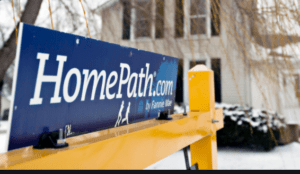Fannie Mae HomePath is a program that speeds up the process of selling foreclosed homes. This helps Fannie Mae in its mission to help homeowners avoid and prevent foreclosure by working with organizations—such as housing counselors and mortgage companies. If foreclosures happen, Fannie Mae HomePath helps to sell the properties as quickly as possible to help minimize the impact on defaulting homeowners.
How Does Fannie Mae HomePath Work?
HomePath is an online program through which you can purchase Fannie Mae-owned properties that are going to be foreclosed. Fannie Mae will acquire these properties by a deed-in-lieu meaning that the homeowner voluntarily gives up ownership of their home to the mortgage company.
Once a home is listed on the HomePath website, you work with a real estate agent to tour the home and make an offer. The HomePath program only accepts offers from Fannie Mae-approved listing agents, but you can work with a local agent to help you submit an offer to the listing agent.
The homes on HomePath are priced competitively since Fannie Mae’s goal is to try and sell off these properties quickly. This means that first-time homebuyers or those looking to purchase a bigger home for less will most likely benefit.
Fannie Mae also offers incentives like flexible mortgage terms and low down payments for some properties. It also offers special financing options, such as the HomeReady® mortgage and HomePath Ready™ Buyer programs. Real estate investors may be able to benefit but they may not qualify for the same financial incentives that homeowners would.
Fannie Mae also offers a First Look™ program for those who intend to purchase a primary residence. Houses listed under First Look™ are new listings that only accept bids from homeowners within the first 15 days of listing. Buyers who don’t plan on moving in cannot bid in the first 15 days a First Look Home is listed.
What is a Fannie Mae HomePath Property?
A HomePath property is any home that’s owned by Fannie Mae as a result of a foreclosure. There are a variety of choices, ranging anywhere from condominiums to single-family homes. Sales prices and the number of homes can vary depending on your area. The only way to tell what types of properties are available is to look on the HomePath website and search for the area code of your choice.
The condition of HomePath properties varies as well. Many are considered move-in ready, while others may require repairs before they’re habitable. Fannie Mae mentions that the company may make repairs to help market the home, but that doesn’t guarantee that there won’t be more. Fannie Mae sells each home as-is, which means you’ll be responsible for handling any repairs or problems after closing.
Furthermore, Fannie Mae doesn’t guarantee any repairs or renovations that have been completed on a home. If it’s made aware of any hazards or major issues on a property, listing agents will be informed. You should hire a qualified professional, such as a home inspector to check out the property before purchase. You may buy a home warranty—is available—but do your research before deciding if it suits your situation.
Requirements of the HomePath Program
When purchasing a HomePath property, you must submit an offer to a Fannie Mae-approved listing agent. Your offer has to be submitted in writing and, if applicable, by a specified time and date.
They don’t accept contingent offers, which means you won’t be able to request that the seller take the house off the market and wait for you to sell your previous property before closing. You also don’t need to obtain a lender’s prequalification statement before submitting an offer. However, a prequalification statement may help you get financing and close on a home more quickly.
You can purchase a HomePath property using a conventional mortgage loan. The usual requirements include a minimum credit score of 620, although a higher score will give you better rates. You’ll also want to have a maximum loan-to-value ratio of 80%, and your debt-to-income ratio must be equal to or less than 36% of your monthly gross income. Most mortgage companies also ask that you have a 20% down payment. If your down payment is less than 20%, you may need to purchase private mortgage insurance.
Fannie Mae HomePath Financing Options
Fannie Mae offers a few financing options to help those who want to purchase a home, but may not be able to do so through a conventional mortgage.
- HomeReady® Mortgage Program: HomeReady® is for those who want to buy a single-family home and can meet the income limits in their area. A 3% down payment and co-borrower flexibility are among the features included. To qualify, you’ll need to complete an online homeownership course run by Framework. This mortgage program is available for those who purchase a HomePath property or not.
- HomePath Ready Buyer™ Program: Homebuyers who complete the HomePath Ready Buyer online education course by Framework and purchase a HomePath property can receive up to 3% back in closing costs. You can combine both the HomeReady mortgage and Ready Buyer™ program on the same purchase.
In conclusion, Fannie Mae’s financing options make it relatively easier to purchase a home than with a conventional mortgage. The HomePath program provides options for financing assistance, competitive pricing, and speedy closing.
You can choose the financing option that suits your needs, including FHA, VA, and USDA loans if they make more sense. In other words, as long as you comply with all requirements, you can take advantage of all the benefits the HomePath program offers.
Social Accounts: Facebook, Twitter, Tumblr, Wikipedia, Pinterest